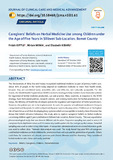Caregivers’ Beliefs on Herbal Medicine Use among Children under the Age of Five Years in Silibwet Sub-Location, Bomet County

View/
Date
2023-11Author
KIPTUI, Fridah
MIIMA, Miriam
KIBARU, Elizabeth
Metadata
Show full item recordAbstract
The Declarations of Alma Ata and Astana recognized traditional medicine as part of primary health care.
About 80% of people in the world today depend on traditional medicine to meet their health needs,
because they are considered easily accessible, safe, cost-effective, and culturally acceptable. For this
reason, the World Health Organization (WHO) devised a strategy to help member states formulate policies
for regulation of herbal medicine production, use and practice. Many countries, in response to the WHO
strategy, have formulated policies, research centres, and training institutions for herbal practitioners. In
Kenya, the Ministry of Health has developed policies for regulation and registration of herbal practitioners.
However, the policies are yet to be implemented. As such, the practice of traditional medicine in Kenya is
unregulated and the products sold could potentially pose harm to the population. Children are at the highest
risk of harm because of their developing body systems which are susceptible to toxicity. Since literature has
shown that beliefs influence behaviour, this study aims to explore caregivers’ beliefs on herbal medicine
use among children aged 5 years and below in Silibwet Sub-Location, Bomet County. This was a qualitative
phenomenological study that was done in Silibwet sub-location. Purposive sampling was used to select 10
caregivers for in depth interviews and 15 community health workers for focused group discussions. Snowball
sampling was used to select 6 key informants. A researcher-administered semi-structured interview guide
was used to collect data. Thematic data analysis was used. The study found that over 90% of caregivers
used herbal medicines on their children for protection from evil eyes and for promotion of growth. Others
used them for treatment of cultural, common and chronic illnesses and for cleansing. They considered
herbal medicine safe, cheap and easily available.
